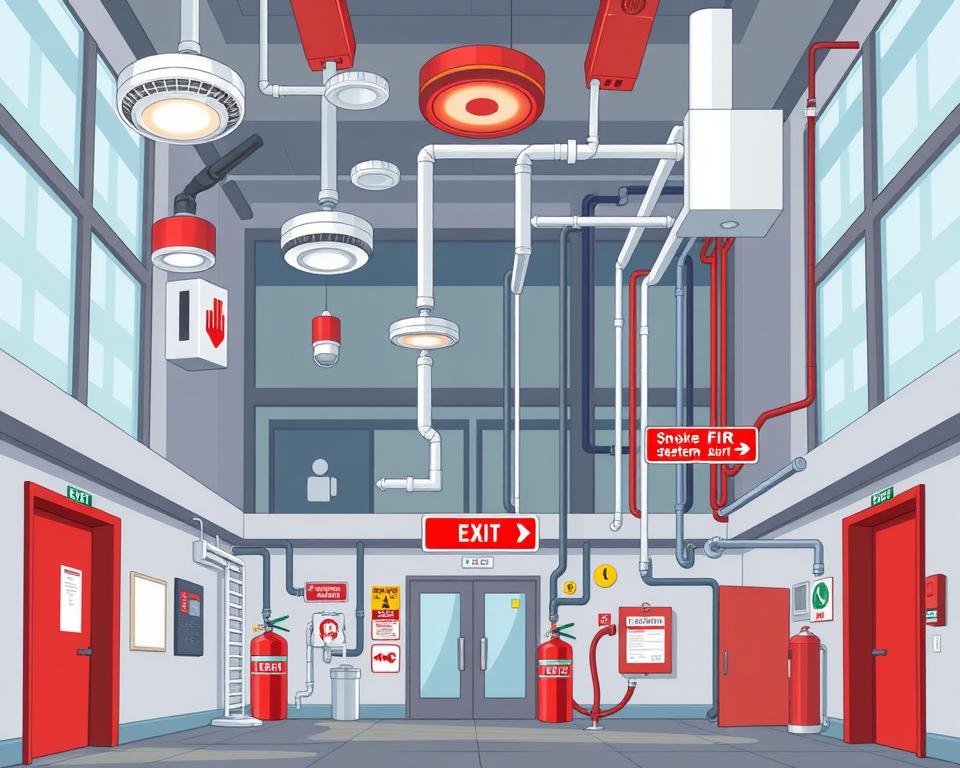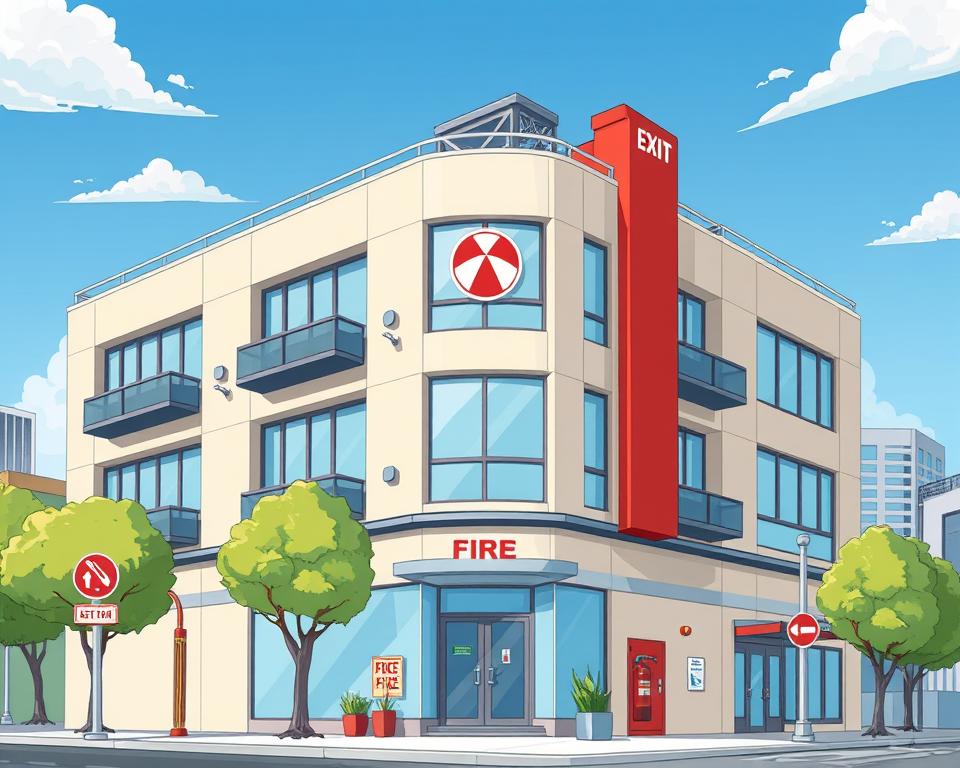In Australia, fire safety is not merely a suggestion—it’s a stringent set of obligations shaped by historical wisdom and modern benchmarks. With the Work Health and Safety Regulation 2011 as the lifeblood of our national approach, adherence transcends choice and becomes an imperative across the territories since January 1, 2012. Yet, as we consider our workplaces under the microscope of fire safety obligations, one can’t help but ask: Are we doing enough to prevent tragedies?
As custodians of safety, our role extends beyond mere compliance; it’s about fostering a sanctuary against the unforgiving nature of fire through meticulous fire risk assessments and robust emergency evacuation plans. We decipher the language of legalities like AS3745-2010, which dictates emergency planning in facilities, and AS4083-2010, focused on healthcare setting vigilance, to weave a tapestry of security that’s both lawful and life-preserving.
Obligations morph into actions—Queensland’s adherence to the Building Fire Safety Regulation 2008 and Tasmania’s devotion to the General Fire Regulations 2010 shine as beacons of regional commitment. We equip our establishments with the tools of survival, where reliable fire alarm systems, extinguishers, and fire blankets become the tangible pillars holding up our protective canopy.
Yet, while we engrain procedural choreography through drills and training, highlighting each exit route and assembly point, the lingering question remains—to what extent do these measures safeguard the beating hearts and curious minds populating our nation’s endeavours? As we look beyond our shores to examples like OSHA and NFPA in the United States, seeking continuous improvement becomes our mantra.
We must invoke a collective consciousness about the vital essence of fire safety: a resolute commitment that leaves no door unchecked, no alarm unheard, and no individual untrained in the symphony of survival that is emergency response. We, as Australians, owe it to ourselves and each other to cultivate a culture where fire safety obligations transcend the ink on legislative pages and become the rhythm of our everyday workplace vigilance.
The Importance of Fire Safety Regulations in Australia
Fire safety regulations in Australia are fundamental to ensuring safety and orderly management in both residential and commercial properties. Recognizing the severe implications of fire incidents, the Australian government has implemented rigorous measures to prevent and react appropriately to fire emergencies. Central to these efforts is a comprehensive legal and regulatory framework designed to uphold high safety standards.

The NCC serves as a cornerstone for building safety, embedding fire safety regulations that promote the safe evacuation of building occupants during emergencies. This code specifies requirements for fire hazard identification, ensuring that potential risks are addressed in the planning stages of construction and operation of buildings.
The Evolution of Fire Safety Obligations: Lessons from History
Examining historical events provides insight into the evolution of fire safety regulations. Urban planning responses to incidents such as the Great Fire of Rome and the Great Fire of London have heavily influenced today’s fire safety standards in Australia, guiding modern safety measures and strategies.
Contemporary Fire Safety Requirements and Compliance
Today’s fire safety landscape in Australia focuses intensely on both active and passive fire prevention measures. These incorporate regular fire safety training and the strategic placement and maintenance of fire extinguishers. With fire safety training mandated by law, businesses must ensure employees are well-trained to react swiftly and appropriately during fire outbreaks, significantly boosting workplace safety.
Key Measures Include:
- Regular and comprehensive fire hazard identification to recognize potential risks timely.
- Compulsory fire safety training for employees, focusing on the correct use of fire extinguishers and adherence to emergency protocols.
- Installation of fire detection and suppression systems, guided by Australian standards, to ensure rapid and effective response during emergencies.
- Maintenance of all safety equipment to meet stringent regulatory standards, ensuring functionality at critical moments.
In sum, the amalgamation of historical lessons, strict regulations, and continuous education forms the scaffold of fire safety in Australia, aiming to mitigate risks and protect lives and property.
Fire Safety Obligations in Practice: Understanding FRLs and Fire-Source Features
In our continuous effort to enhance fire safety standards, understanding Fire-Resistance Levels (FRLs) and accurately identifying fire-source features form the cornerstone of effective fire hazard identification and fire prevention measures. FRLs, as outlined by Australian Standard AS 1530.4, determine how long building components can withstand fire, crucially maintaining their structural integrity, which prevents the spread of fire and facilitates safe evacuation and fire-fighting efforts.
Effective fire prevention hinges on systematic fire hazard identification. This not only encompasses assessing inherent risks within a building’s design and materials but also involves evaluating external risks posed by nearby structures or natural features. This dual approach ensures that fire prevention measures can be tailored to mitigate specific threats effectively.
Fire alarm systems play a crucial role in our defense against fires, providing the earliest possible warning to occupants and fire services. Investing in advanced fire alarm systems can significantly boost response times and the effectiveness of emergency procedures, ultimately saving lives and minimizing property damage.
- Assessment of structural adequacy and integrity over time under fire exposure.
- Strategizing insulation properties to delay the impact of heat and smoke.
- Identifying potential ignition sources close to or within the building.
- Implementing robust fire alarm systems and regular maintenance checks.

Let us remember, the rigor with which we approach fire hazard identification and the completeness of our fire prevention measures directly influence the effectiveness of our fire safety strategies. By integrating comprehensive fire alarm systems and upholding stringent FRL requirements, we create safer environments that stand resilient against fires.
Additionally, continuous review and upgrade of fire safety protocols, coupled with regular training for staff on the latest fire safety practices, ensure that the occupant’s safety is always prioritized and that compliance with updated regulations is maintained.
Fire Safety System Compliance: Annual Fire Safety Statements
Ensuring compliance with fire safety regulations is paramount for building owners in Australia. Each year, it’s essential to submit an Annual Fire Safety Statement (AFSS) to the respective council and Fire and Rescue NSW, confirming that all fire safety measures, such as fire extinguishers and emergency evacuation plans, are in place and operational. This not only enhances the building’s safety but also ensures adherence to legal obligations.
Fire safety training plays a critical role in preparing staff and occupants on how to respond during emergencies effectively. Such training typically includes handling fire extinguishers correctly and familiarisation with emergency evacuation plans. These elements are essential components of the AFSS, which must accurately reflect the current state of the building’s fire safety measures as verified by accredited practitioners.
What Constitutes a Fire Safety Measure?
Essential fire safety measures include various systems and equipment, like alarms, sprinklers, and fire extinguishers, which must function at or above the performance level they were originally designed and installed for. These are vital for the safe evacuation of occupants and the effective management of fire incidents.
Stipulations of the Fire Safety Schedule for Australian Buildings
Every building completed on or after July 1, 1988, is equipped with a Fire Safety Schedule (FSS), which outlines each required fire safety measure. This schedule is a critical document in the submission of an AFSS. It ensures that building owners can verify that all measures not only exist but are maintained to perform effectively in preventing and controlling fire incidents.
To maintain compliance and avoid penalties, here’s what building owners should remember:
- AFSS must be submitted annually to confirm the inspection and functionality of fire safety measures.
- A one-off extension of up to six months can be granted in certain circumstances, like unanticipated legitimate events.
- Councils impose higher fees for late submissions of AFSS requests, thus punctuality is crucial.
For further details on fire safety certification and compliance, visit the official guidelines. Staying updated and compliant not only ensures the safety of building occupants but also aligns with national fire safety standards, making it an essential aspect of responsible building management.
Key Fire Safety Obligations for Building Owners and Managers
As building owners and managers in Australia, it is crucial to understand the heavy responsibilities placed upon us to ensure the safety and well-being of occupants. These responsibilities are not just legal obligations but moral ones, ensuring that everyone within the building can safely evacuate in the event of a fire and minimise risks associated with fire incidents.
Fire safety management involves comprehensive planning and regular execution of several key tasks:
- Fire Risk Assessment: Conducting thorough assessments regularly to identify potential fire hazards within the building.
- Emergency Evacuation Plans: Developing and maintaining clear and accessible evacuation routes and procedures tailored to the building’s layout and occupancy.
- Fire Drills: Organising regular drills to ensure all occupants are familiar with evacuation procedures. This is particularly vital in high occupancy buildings where swift evacuation is challenging.
- Fire Safety Training: Providing residents and staff with training on how to use fire safety equipment like extinguishers and fire blankets, and educating them on maintaining safety and responding effectively in fire situations.
Consideration of local legislation is also essential. For instance, Queensland’s fire legislation underpins our efforts in maintaining very low risks of fire-related incidents. Special attention must be given to the Environmental Planning and Assessment (Development Certification and Fire Safety) Amendment (Fire Safety) Regulation 2022, which introduces stringent requirements for reducing safety risks, property damage, and defects.
Furthermore, the maintenance of fire safety equipment and systems as per the AS1851 standard is imperative. This includes monthly servicing of essential fire safety measures to ensure functionality at all times. Failure to comply with these regulations could lead to severe financial penalties, which emphasise the seriousness of these responsibilities.
The role of a designated Fire Safety Advisor is crucial for buildings exceeding 8 floors or accommodating more than 30 workers, ensuring dedicated oversight and compliance with fire safety norms. Additionally, ongoing documentation such as the annual fire safety statement (AFSS) is required, especially for residents in multi-residential buildings in New South Wales, to certify adherence to fire regulations.
Ultimately, the goal of these fire safety obligations is to ensure a safe environment for all occupants and to mitigate the risk of fire-related damages. As building managers and owners, staying informed, proactive, and compliant are the cornerstones of effective fire safety management.
Meeting Australian Fire Safety Standards: Advice for Businesses
As businesses operating in Australia, it is incumbent upon us to rigorously fulfil our fire safety obligations. To ensure the safety of our workforce and the continuity of our operations, maintaining and regularly servicing fire alarm systems, fire extinguishers, and all other fire protection equipment is a non-negotiable standard. Adherence to the AS 1851:2012 is critical in this regard, as it encapsulates the maintenance of protective equipment, and our compliance is instrumental in preventing legal liabilities and fostering a secure working environment.
In light of this, we must initiate regular fire safety audits. These audits aid in potentially reducing insurance premiums by showcasing our commitment to effective fire safety measures. Furthermore, changes in personnel or the introduction of new machinery can significantly alter the dynamics of our fire safety plan. Thus, it’s essential to re-evaluate emergency response plans and update training programs accordingly. Notably, AS 1851 covers crucial aspects, including evacuation plans and fire detection systems while highlighting the need for scheduled inspections and maintenance of essential safety measures (ESMs) to avoid the harsh penalties that result from non-compliance.
To remain diligent in our fire safety practices, we recommend conducting at least annual fire safety audits, or more frequently in response to significant operational changes. Adapting to regulatory updates, machinery enhancements, and proposing procedural alterations post-fire incidents are all part of our continuous effort to guarantee a safe workplace. Embracing the full spectrum of AS 1851’s maintenance requisites and ensuring precise record-keeping will not only mitigate liabilities but also affirm the integrity and reliability of our fire safety protocols, ensuring the wellbeing of all stakeholders and the resilience of our business.
FAQ
Q: What are the fundamental fire safety obligations in Australia?
A: In Australia, the fundamental fire safety obligations include conducting fire risk assessments, establishing and maintaining emergency evacuation plans, ensuring the functionality of fire alarm systems, and adherence to the National Construction Code (NCC) and other relevant Australian Standards.
Q: How regularly should a fire risk assessment be conducted?
A: Fire risk assessments should be conducted regularly to ensure that all potential fire hazards are identified and mitigated. The frequency may depend on the type of building, its use, occupancy levels, and any changes to structure or use. It is recommended that a professional assessment is done at least annually.
Q: What should be included in an emergency evacuation plan?
A: An emergency evacuation plan should include detailed routes out of the building, assembly points, procedures for accounting for all occupants, individuals with specific roles during an evacuation, and accommodations for individuals with disabilities. Plans must be clearly communicated to all occupants and regular drills should be conducted to ensure familiarity.
Q: What role does the National Construction Code (NCC) play in fire safety?
A: The NCC provides the minimum necessary requirements for the design and construction of buildings in Australia, including fire safety provisions aimed at ensuring the safe evacuation of occupants and reducing the spread of fire between buildings.
Q: How have historical events shaped current fire safety obligations?
A: Significant fires in history, such as the Great Fire of Rome and the Great Fire of London have influenced the development of modern fire safety obligations. These events led to the realisation of the importance of urban planning and building materials and design that consider fire safety, principles that are embedded in today’s regulations.
Q: What are some of the contemporary fire safety requirements for compliance in Australia?
A: Contemporary fire safety requirements in Australia include the installation of fire extinguishers, provision of fire safety training to occupants, the implementation of fire hazard identification processes, and adherence to the specific Australian Standards for each safety measure. Regular inspections and maintenance are also mandated to ensure ongoing compliance.
Q: What is a Fire-Resistance Level (FRL) and why is it important?
A: A Fire-Resistance Level (FRL) indicates the duration for which a building element can withstand fire, in terms of maintaining its structural integrity, preventing the passage of flames and smoke, and not exceeding a certain temperature on the non-fire side. Understanding FRLs is crucial for ensuring that buildings can prevent or delay the spread of fire, allowing for safe evacuation and potentially saving lives.
Q: How does the identification of fire-source features impact fire safety?
A: Identifying fire-source features is essential as it allows building designers and owners to implement protective measures that consider the proximity and potential impact of external fires. Fire prevention measures can then be tailored to mitigate specific risks related to these features, enhancing the overall fire safety strategy of the building or facility.
Q: What is an Annual Fire Safety Statement (AFSS) and what does it certify?
A: An Annual Fire Safety Statement (AFSS) is a document required in Australia which certifies that a building’s fire safety measures have been assessed and are found to be performing to the standards stipulated by the NCC and the relevant Australian Standards. It must be submitted to the local council and fire brigade annually.
Q: What are the key stipulations in a fire safety schedule for Australian buildings?
A: A fire safety schedule lists all the fire safety measures that are required in a building, their performance standards, and the frequency of inspections and maintenance. It details the obligations of the building owner or manager in keeping these measures in compliance with the relevant Australian Standards.
Q: Why are fire drills important for building occupants?
A: Fire drills are critical as they provide occupants with the knowledge and experience to evacuate promptly and safely in the event of a real fire. Regular drills help to ensure everyone understands the evacuation procedure, minimising confusion and panic during a potential emergency.
Q: What does fire safety training entail for building occupants?
A: Fire safety training for building occupants involves educating them about fire risks, the correct use of fire extinguishers, recognising and responding to fire alarms, evacuation procedures, and their roles during an emergency. Training helps ensure that everyone in the building knows how to act if a fire occurs.
Q: What are the responsibilities of businesses under Australian fire safety standards?
A: Under Australian fire safety standards, businesses are responsible for ensuring that fire alarm systems and fire extinguishers are installed and maintained according to Australian Standards, such as AS 1603 and AS 1851. They must also carry out regular inspections, testing, and service fire safety equipment, conduct fire drills, and provide appropriate training to their staff.
Q: How can businesses ensure compliance with fire safety regulations?
A: Businesses can ensure compliance by conducting regular and thorough fire risk assessments, adhering to the Australian Standards for all fire safety equipment, keeping up to date with the latest fire safety regulations, and submitting the required documents such as the AFSS. Consulting with accredited practitioners for inspections and services is also recommended.

